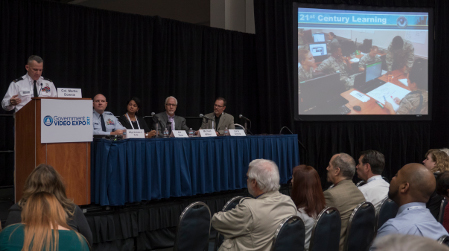Making Effective Government Video in the Age of Snapchat
WASHINGTON—Social media has changed how communications professionals operate in all spheres and the new platforms offer their own challenges and opportunities for those working for the federal government.

At Government Video Expo 2017, attendees learned how the Department of Defense, the Environmental Protection Agency, Department of Health and Human Services and the Department of the Interior are able to take advantage of YouTube, Facebook, Twitter and other forms of social media to spread their agencies’ messages.
“Visual First—Smart Use of Video in Social Media and Beyond” was moderated by Defense Information School Commandant Col. Martin Downie. The panel was composed of DINFOS Video Skills Instructor MSgt. Nicholas C. Kurtz; EPA Office of Multimedia Assistant Director Jini Ryan; Department of Health and Human Services Director of Broadcast Communications Michael Wilker; and Department of the Interior Deputy Director of Digital Strategy Larry Gillick.
Downie came to DINFOS two years ago, and in that time his goal has been to transition the school to a 21st century learning environment. That means the schoolhouse (as Downie calls it) now has Wi-Fi and they have plans to soon distribute iPads to their students. Also important: Downie wants instructors to move from the “sage on the stage” mentality to “the guide on the side” to promote an active learning environment with lots of student engagement. And they engage with industry and academia to learn current best practices.
DINFOS offers 32 courses (ranging from five to 124 days long) as part of a curriculum designed with the military in mind.
Effective fiscal year 2020, DINFOS will begin a curriculum that teaches communication, journalism, PA, photo, video and digital/multimedia in the course of 108 days. It’s the standard for all Department of Defense communicators. They also offer 10-day classes in storytelling, CBT photo/video, graphic design and broadcasting.
As a DINFOS video instructor described by Downie as “the go-to-guy,” Kurtz explained the school’s strategy for teaching DoD professionals video in the internet age.
The professional video industry's #1 source for news, trends and product and tech information. Sign up below.
First, the content should be social media-focused; meaning, “snackable,” generating audience engagement, applying the quality over quantity principle and “less broadcast, more Buzzfeed” style.
Second, DINFOS is transitioning away from heavy ENG gear. Instead of shoulder-mount cameras, Kurtz focuses on teaching students how to use DSLRs and smartphones effectively. Additionally, the concept of the edit station is increasingly becoming obsolete; more editing is done on iPads today.
Finally, Kurtz says to keep in mind that the goal is information with an immediate impact.
According to Kurtz, today’s students have an innate understanding of many of these best practices because “social media is their second language.”
Next, Ryan discussed how social media has affected the workflow for sharing EPA announcements. Most announcements are now live streamed via the EPA’s official YouTube channel.
Ryan noted that the platform has made improvements to its backend that are helpful for content producers. For example, the initial stream can be saved, then cleaned up and shared in its entirety or cut into subclips that are ideal for sharing on Facebook or Twitter.
The EPA is still tethered to the building for live streaming, but they are in the process of testing out smartphones that are compatible with DSLRs. Ryan explained they would use cell towers for connectivity and would also have the advantage of being smaller and lighter—ideal for visiting a remote location.
Wilker explained that the Department of Health and Human Services primarily streams advisory committee meetings to interested audiences.
Keeping with the theme, he joked that “Captioning is a human service,” and an important element of sharing information with the public. In the spirit of going above and beyond, Wilker doesn’t trust live captioning’s accuracy (despite claims that it is highly accurate, it isn’t good enough). Instead, he sends the MP3 file to NCC for full transcription. Wilker says he likes to give people more than they expect.
Continuing that theme was self-confessed contrarian Gillick. After playing Interior’s most popular video (featuring proposals and weddings at National Parks for Valentine’s Day), he reminded audiences that, as a federal agency employee, it is not his “job to create pretty things.” Rather, he is furthering a larger goal.
But that doesn’t mean he and his employees can’t be “nice.” In fact, there DOI.gov website offers a button that will switch all the text to a Dyslexic-friendly font (How’s that for 508-compliance?).
Gillick also voiced a bit of a surprising opinion for a social media-focused panel. He believes that U.S. citizens should not have to go to an outside platform (like Facebook, Twitter, YouTube, etc.) to get information from the government. That’s why he focuses the majority of his energy on his agency’s website.
He advised the audience that there is no magic formula for audience engagement or higher traffic. But if what you’re doing is working, he said, embrace it—but only for as long as it works—and be smart enough to know when it isn’t.
